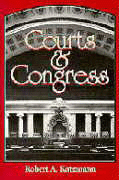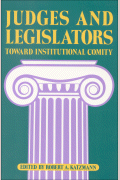Like a bad penny, the “Thurmond Rule” is surfacing again in Senate debates over judicial confirmations. Both parties have invoked it over the last several decades. Today, it and other myths are obscuring the 114th Senate’s meager confirmation record.
What is the Thurmond Rule?
South Carolina’s Strom Thurmond chaired the Senate Judiciary Committee from 1981 to 1987. His unwritten admonition holds that in presidential election years, the Senate should stop processing judicial nominations around the time of its summer recess, perhaps with limited exceptions for clearly non-controversial nominees. The current chair, Senator Charles Grassley (R-IA) said during a May 19 Committee business meeting that “there’s been a lot of discussion and frankly, disagreement about [the rule], what it means, and when it goes into effect,” noting however that “[d]uring the last four presidential election years, the last confirmation vote of a circuit court nominee occurred before the summer recess. And the final confirmation vote of a district court nominee occurred in the fall of that year.”
Grassley didn’t rule out further confirmations, because the rule “is fairly flexible.” Senator Diane Feinstein (D-CA) responded that the Senate should consider “getting rid of” the rule and “just . . . do our jobs and process” nominations. It’s hard to argue with the second part of the statement, although the first part makes sense only if the Senate can “get rid of” the unremarkable proposition that confirmations in presidential election years will usually slow more quickly and stop sooner than in other years.
Grassley’s description of the paucity, since 2000, of presidential election year confirmations after the summer recesses obscures the amount of election-year confirmations prior to the recesses. The Senate confirmed from four to eight circuit judges in each of those four years (2000, 2004, 2008, and 2012), compared to only one so far in 2016. And it confirmed, before the recesses in those years, 27, 24, 14, and 28 district judges, compared to only six so far in 2016. (And, any Thurmond “rule” notwithstanding, in those four years the Senate confirmed 36 district judges after the recesses—not to mention ten post-August circuit confirmations in 1984, 1988, and 1992, during and immediately following Thurmond’s chairmanship.)
Grassley said that “because there is no hard and fast rule, the best way I know how to proceed is to look to what has been done in the past, and roughly follow the examples of my predecessors.” The examples from the four presidential election years he cited call for the Judiciary Committee—before the Senate begins its month-and-a-half recess on July 18—to hold hearings for at least some of the 23 district and six circuit nominees who haven’t had them. Those examples should motivate the full Senate to consider at least the 21 district and one circuit nominees who have had hearings. Doing so could help close the yawning gap between the 114th Senate’s record of 18 total confirmations and those of its recent predecessors—72 in 1999-2000 when Republicans controlled the Senate and 68 in 2007-08, when Democrats did.
Other confirmation myths
In April, Senate Majority Leader Mitch McConnell announced another excuse for not confirming nominees. In blocking requests for more floor votes, he said “President Obama [has] been treated fairly with regard to the confirmation of judges during his tenure in office …. [S]o far during the Obama years he’s gotten 23 more judges than President [George W.] Bush got to this point.” Although Obama’s overall confirmation rate is now slightly below Bush’s, McConnell is correct as to the raw numbers. As of May 25 of their eighth years, the Senate had confirmed 321 Obama nominees (55 circuit and 266 district), versus 299 Bush nominee (58 circuit and 241 district).
But McConnell’s comparison is akin to saying that Congress treated a hypothetical President X fairly by providing slightly more hurricane relief funds than it provided President Y, even though President X’s term saw twice as many hurricanes as did President Y’s.
The judicial analogy to natural emergencies is vacancies. When Democrats took control of the Senate in January 2007, there were 16 vacant appellate and 40 vacant district judgeships. In late May of 2008, appellate vacancies were down by five and district vacancies by four, largely because during those 17 months, the Senate confirmed eight circuit and 38 district nominees. When Republicans took control of the Senate in January 2015, there were seven vacant appellate and 33 vacant district judgeships. Circuit vacancies have increased by two, with four more in the wings. District vacancies have more than doubled, to 67, with nine in the wings. During that 17-month period, the Senate has confirmed two circuit nominees and 16 district nominees.
In the comparable 2007-08 period, vacancies that the United States Judicial Conference deemed “judicial emergencies” (based on caseload and vacancy age) dropped from 25 to 15. Since January 2015, they’ve risen from 12 to 29.
Consider Texas, where ten of the state’s 52 district judgeships are vacant; all ten are judicial emergencies, affecting both criminal prosecutions and commercial interests. The median time since the vacancies’ announcements is over two years. The White House and the state’s Republican Senate delegation have agreed on only five nominees, submitted in March. Looking to predecessors’ examples, the Senate confirmed both of Bush’s March 2008 nominees.
Or consider two-district judgeship Idaho, where one judge announced in September 2014 that he would create a vacancy by leaving active status the next July. The White House and the state’s Republican Senate delegation agreed on a nominee for this judicial emergency only early last month. Looking to predecessors’ examples, the Senate confirmed all four of Bush’s April 2008 nominees.
Republican senators in other states have expressed support for confirming at least some of the nominees in their states, albeit with varying levels of enthusiasm.
The question, in other words, is not fairness to a president but fairness to litigants and judges. Section 2, Article 2 does not terminate the Senate’s “advice and consent” function once it confirms the same number of nominees as those of a prior president, or, despite any “Thurmond Rule,” once it leaves town in July for a month and a half of party conventions and presidential election year campaigning.










Commentary
The “Thurmond Rule” and other advice and consent myths
May 25, 2016